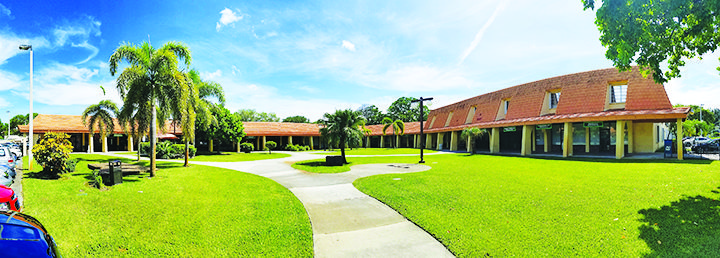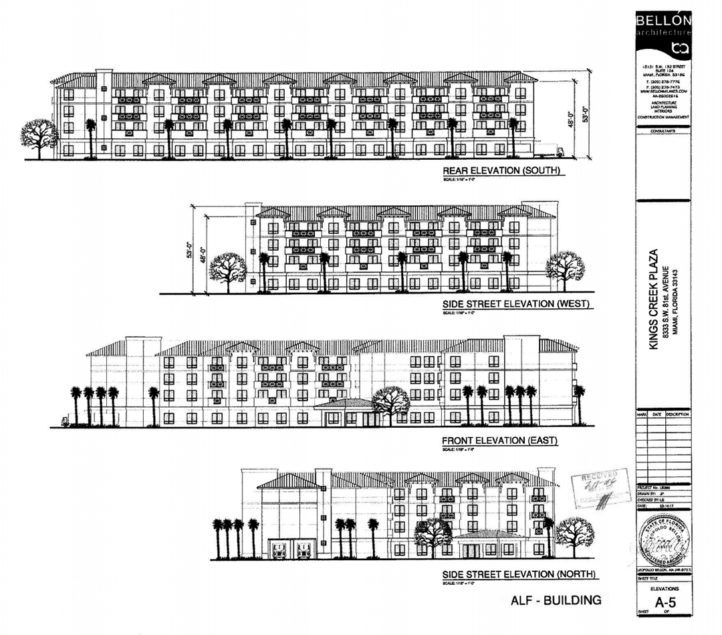
The new owners of Kings Creek Shopping Center and nearby residents agree that the neighborhood plaza is long overdue for redevelopment, but they are having trouble coming to terms with how to move forward.
Part of the problem, some residents said, is that they’ve been lied to.
Since purchasing the property in January 2016, Jose Pereira and David Perez of the limited liability company, JDP Equities, have presented to neighbors and the county three different versions of an assisted living facility (ALF) they plan to build on the 4.3-acre parcel on which the mall sits.
The first, filed during a pre-application in June 2016, listed the ALF as a four-story structure of approximately 122,000 square feet. A second and larger version, photographed during a meeting between JPD Equities and Kings Creek homeowners in October 2016, was five stories and 152,000 square feet.
An application submitted to the county on Mar. 31 again presented the building as a four-story structure, but with a reduced square footage of 113,564.
The height and size discrepancies between documents turned into the county and what was shown to residents, according to Alfredo Manrara, operator of KingsCreekNeighbors.com, were a “clear attempt to deceive the neighbors.”
“It is customary for developers to present something bigger than what they really intend to build so they can show to the decision-makers or county people voting on this that they have actually reduced the size to appease the neighbors,”Manrara said. “We are certainly very concerned about that, because the credibility of this developer is seriously in question.”
While a larger ALF would be more financially feasible, Pereira said, what was presented to neighbors was, despite a smaller four-story proposal for the ALF already in county records, an expression of his and Perez’s ideal plan. He claimed the pushback from neighbors convinced them to go with the smaller structure in the official application phase.
“We were very truthful,” he said. “What we presented to [residents] is what we wanted, but [their response] caught us by surprise. We said, ‘Let’s tame this down a bit and bring it to four [stories] and see how that goes.’”

Pereira said when he and Perez bought the 45,092-square-foot mall, their research found that the highest-value option with the lowest traffic impact would be to upgrade and add a third floor to the existing retail mall and office building and erect a four-story ALF and three-level garage.
The project would more than triple the property’s lot coverage and make the total structure size 6.3 times larger, according to plans submitted to the county. However, parking spaces on the property would only increase from 215 to 347 — a number Pereira points to as proof the neighborhood would experience just a minor uptick in daily traffic.
“To build all commercial would require over 600 parking spots, because it’s possible you may have that many people there in one shot,” he said. “Parking requirements being half that would naturally give you less traffic.”
But neighbors have said the construction stands in stark contrast with the character of the area and could unnecessarily congest the roadways in and around Kings Creek. Manrara said a petition opposing the construction has accumulated more than 300 signatures since it began circulating physically and online.
“Kings Creek is a jewel in Miami; not a lot of people know about it,” said resident Karla Muñoz. “Incrementing traffic here would technically destroy the beauty of our neighborhood — our privacy, our safety.”
Since its construction in 1974, the mall has had a zoning designation (BU-1) permitting retail and convenience facilities defined by the county as satisfying the needs of the “adjacent residential neighborhood.”
Pereira confirmed that shortly after his company purchased the property, he and Perez, as part of their pre-application, applied to change the zoning to BU-1A. This new designation would allow for the construction of “specialized commercial facilities” serving neighborhoods outside the immediate area.
Additional height and setback variances also were requested, according to county records.
“We’re going from a single-purpose convenience shopping center for the immediate neighborhood to an ALF and a regional-size shopping-center-slash-retail-complex,” Manrara said. “Adding the ALF changes the character [of the neighborhood] so much that, in order to build it, [the developers] need a special variance.”
To be approved, construction plans submitted must be consistent with the county’s master plan. But they also must be compatible with the surrounding community, said Carl Harrison, principal planner with the Miami-Dade County Regulatory and Economic Resources (RER) Department. Roadway impact, sufficient parking, aesthetic congruity with the neighborhood and many other factors are considered.
“I’ve already sent [JDP Equities] a deficiency on some aspects of the plan based on an initial review I made,” Harrison said. “That pertains to the height of the buildings and the fact that they need to provide me with more information [about] the amount of beds in the proposed [ALF]. These are things we are going to go through for the next couple months before it’s actually scheduled for hearing.”
Other departments reviewing the application include the Division of Environmental Resources Management, Miami-Dade Fire Rescue, Water and Sewer, and Platting and Traffic Review.
Harrison estimated that the soonest public hearing on the construction would likely take place in September, when neighbors can publicly voice their concerns before the Community Zoning Appeals Board.






